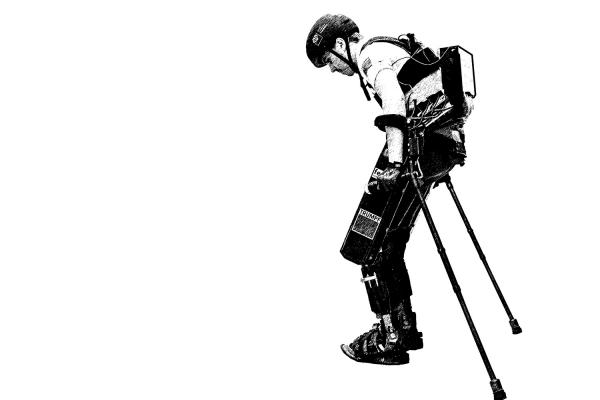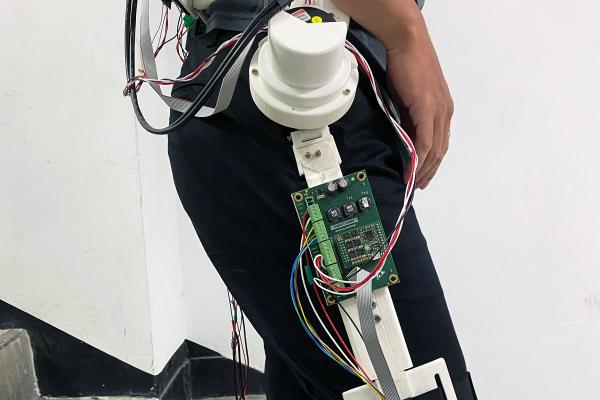It's now ten years since Luc Masson, father of an extraordinary multi-handicapped little girl whom he dreamed of seeing walk, met the Junia team. It was then that these researchers embarked on a feasibility study and built the first version of their exoskeleton, after an initial funding grant. This was the start of Junia's MOTION project.
At that time, the team began working with the Interreg 2 Seas program, a funding program covering Britain, France, the Netherlands, and Belgium. Its main aim is to foster a cradle of innovation in that region, focused on research and knowledge that emphasizes inclusivity and sustainability. A European consortium was created for the MOTION project.
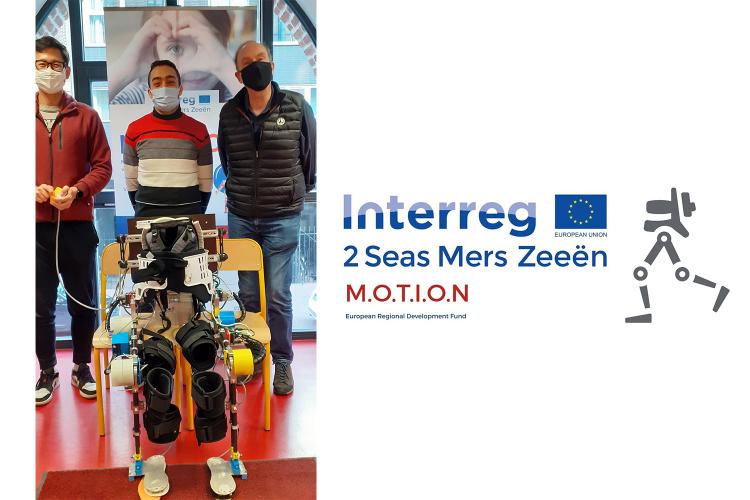
Junia team members and the logo of the Interreg 2 Seas program
The MOTION project
Through co-creation between researchers, engineers, and hospital clinicians, the MOTION project seeks to design and build an exoskeleton for the lower limbs of children with cerebral palsy. Its goal is to help the children and support them in walking, while also measuring their stress and various physiological parameters, using an intelligent suit.
The consortium comprises 14 partners across the four countries covered by the European funding program. They have a total budget of about 7.4 million euros at their disposal. In the Junia team, this means five people working full time on developing the lower-limb exoskeleton. Across all partners, there is a total of 50 people working on the project.
Junia acts as the leader in the MOTION project
The Junia group is one of the leading institutions of private higher education in Europe. Since 1885, it has offered basic education (including engineering degrees at HEI, ISA, and ISEN Lille), research work, consulting services for companies, and continuing professional education.
The Junia group:
- Is recognized as a Private higher education institution of general interest in France (EESPIG)
- Is established on four campuses: Lille, Bordeaux, Châteauroux, and Rabat.
- Currently has 5,000 students, 450 staff, 28,000 graduates.
- It is actively involved in 23 research laboratories and joint supervision of four regional public laboratories.
Laurent Peyrodie, a research professor on the Junia team, outlined the team's many objectives for personal well-being. “To open the door to a better life at home or in hospital, to make exoskeleton technology accessible, and to meet the care needs of children with cerebral palsy (CP), bringing together the expertise of the 2 Seas region. Some children walk on their own, others with a technical aid, and some will never learn to walk. The Junia exoskeleton enables progress and monitoring for children as they learn to walk.”
The exoskeleton can be considered as an alternative to wheelchairs. It could give society a new perspective on the disability, and could act as a springboard for the acceptance of these technologies. They could then also be used for conditions like lower limb hemiplegia.
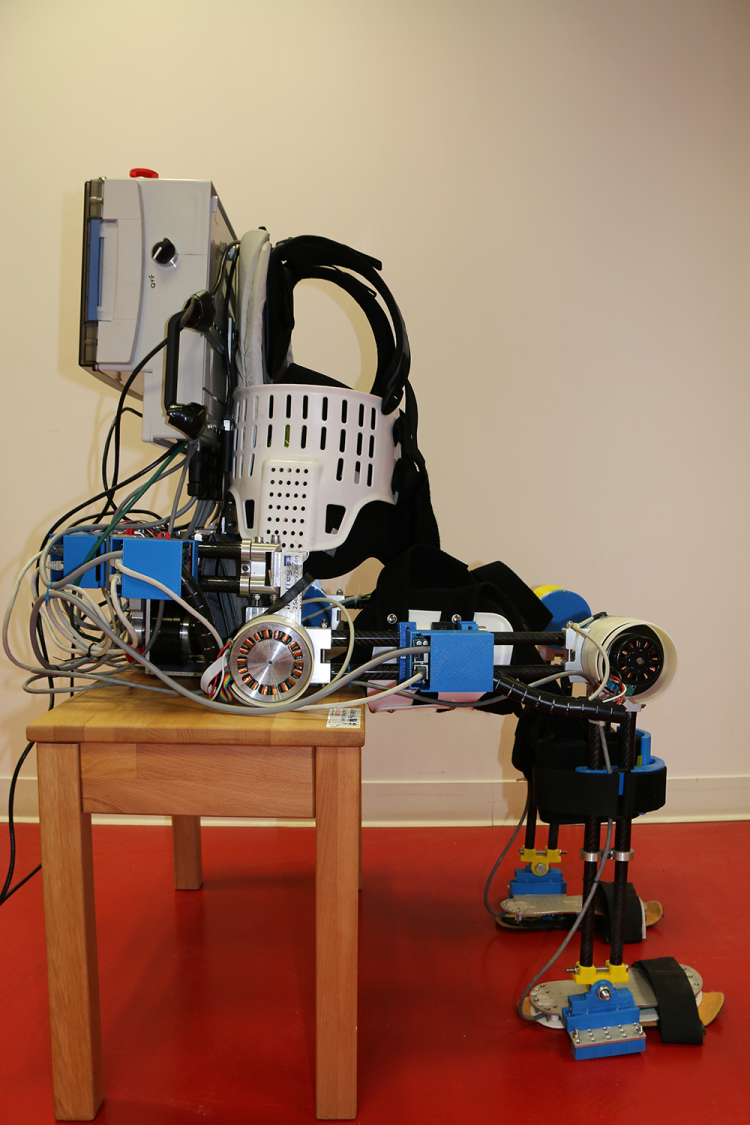
An exoskeleton to address technical challenges
Developing this exoskeleton was not easy. The team had to take into account the child growth during the design process. The task was truly challenging. The lower-limb exoskeleton had to be modular with the same structure for all joints, and autonomous and balanced under any circumstances without any external mechanism. It also had to be secure and suitable for each child based on a structure that can be mechanically adjusted in height and width.
The collaboration between the medical and technical teams allowed the members of the Junia team to develop a mechanical structure that can adapt to changes in the child's physique.
Simulation tools and clinical data were used to test the mechanisms before manufacturing them. Those same tools were used to assess the fundamental torques and ground forces, to determine the choice of motors.
Changing the lives of thousands of children with maxon motors
Many requirements must be met for the exoskeleton. Above all: a good power-to-weight ratio for lightweight design, a compact design which does not impede the user's movement, and high torques that require reduction gearing.
The Junia exoskeleton needs motors with powerful torque and acceleration. They also have to consume the least possible amount of energy, and provide access to control parameters. That's why the Junia team turned to maxon's high-performance motors. They are used to power six joints: two on each hip and one on each knee. The motorization of the exoskeleton's ankles is provided by Mobilab.

3 maxon motors per leg with reducer, one for the knee and two for the hip
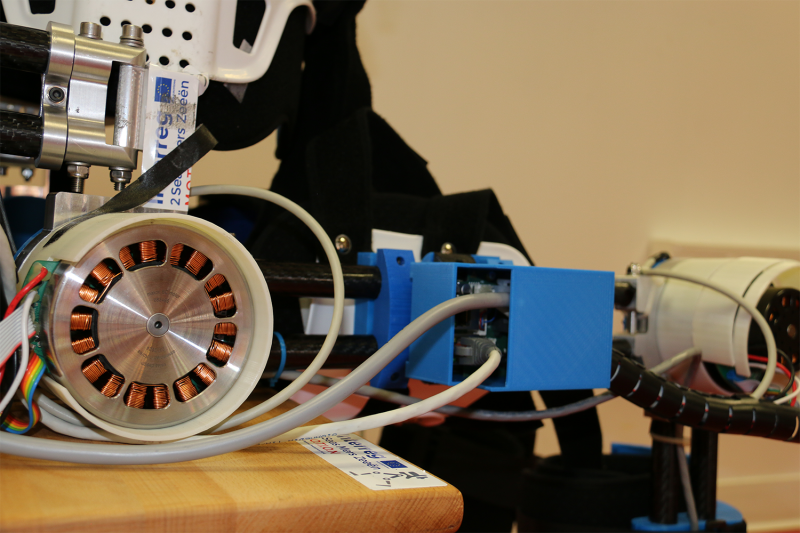
maxon's EC 60 and EC 90 motors and EPOS4 controllers are used to control the exoskeleton, with the motors being networked by EPOS4 EtherCAT drivers.
Now, after a year and a half, a structure designed to adapt to the size and physique of the child has been manufactured and assembled at Junia. This structure links the ankle to the hip developed by KU Leuven. Each leg has three maxon motors with reduction gearing, one for the knee and two for the hip, plus three EPOS4 controllers (for modular digital positioning control). They can be used to test the balance control algorithms while walking.
Collaboration between Junia and maxon France
The Junia team's exoskeleton has precise requirements that only maxon can meet with high quality and reliable products. maxon sells both the motors and the controllers specifically developed for its motors. This combination suits Junia perfectly because it can be easily integrated into the MOTION project. “We consulted blog articles on exoskeletons and robotics, and we know that maxon products are widely used. We want the quality of maxon motors. Based on our calculations, maxon's products are exactly what we need.”
The compactness, weight, and the power-to-weight ratio of maxon products prompted the Junia team to order their products on the maxon online shop, where they benefit from the best prices and delivery times. In addition, the technical support staff at maxon France also helped the technical team at Junia to understand the functions of the maxon controllers to achieve optimal parameter settings.
The future with maxon France
Junia plans to test the exoskeleton on children with cerebral palsy in order to reach level 5 on the technology readiness scale, before moving on to a certification phase with the aim of clinical testing on larger groups of patients.
The structure has been duplicated in Britain, likewise using the maxon products. Everyone in the project is using maxon products, for greater simplicity when the different systems are joined together. “We can use the same type of control, with the same type of control boards. This makes it easier to integrate them later. Naturally, we will recommend the maxon products,” said research professor Laurent Peyrodie.
The next steps for Junia are to finalize the structure in terms of technology. The plan is to test the structure with healthy children and then, in a second phase, with children with cerebral palsy before the end of the year.
Video project MOTION: Ten steps in an automatisch way
maxon's role in this development challenge is crucial, as it keeps proposing new and even more powerful motor systems. At the end of 2021, maxon launched new products designed for dynamic applications that perfectly meet the needs of the market in terms of dynamic response, compactness, and power density.
These include the new EC frameless DT, the first of a family of products for dynamic motion, and the ECX flat range for exceptional performance, available in diameters of 22 mm, 32 mm, and 42 mm.



